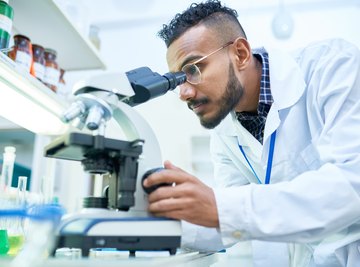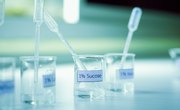
Living things, all of which consist of one or more individual cells, can be divided into prokaryotes and eukaryotes.
Virtually all cells rely on glucose for their metabolic needs, and the first step in the breakdown of this molecule is the series of reactions called glycolysis (literally, "glucose splitting"). In glycolysis, a single glucose molecule undergoes a series of reactions to yield a pair of pyruvate molecules and a modest amount of energy in the form of adenosine triphosphate (ATP).
The ultimate handling of these products, however, varies from cell type to cell type. Prokaryotic organisms do not participate in aerobic respiration. This means that prokaryotes cannot make use of molecular oxygen (O2). Instead, the pyruvate undergoes fermentation (anaerobic respiration).
Some sources include glycolysis in the process of "cellular respiration" in eukaryotes, because it directly precedes aerobic respiration (i.e., the Krebs cycle and oxidative phosphorylation in the electron transport chain). More strictly, glycolysis itself is not an aerobic process simply because it does not rely on oxygen and occurs whether or not O2 is present.
However, since glycolysis is a prerequisite of aerobic respiration in that it supplies pyruvate for the reactions thereof, it is natural to learn about both concepts at once.
What Exactly Is Glucose?
Glucose is a six-carbon sugar that serves as the most important single carbohydrate in human biochemistry. Carbohydrates contain carbon (C) and hydrogen (H) in addition to oxygen, and the ratio of C to H in these compounds is invariably 1:2.
Sugars are smaller than other carbohydrates, including starches and cellulose. In fact, glucose is often a repeating subunit, or monomer, in these more complex molecules. Glucose itself does not consist of monomers, and as such is considered a monosaccharide ("one sugar").
The formula for glucose is C6H12O6. The main portion of the molecule consists of a hexagonal ring containing five of the C atoms and one of the O atoms. The sixth and last C atom exists in a side chain with a hydroxyl-containing methyl group (-CH2OH).
The Glycolysis Pathway
The process of glycolysis, which takes place in the cell cytoplasm, consists of 10 individual reactions.
It is usually not necessary to remember the names of all of the intermediate products and enzymes. But, having a firm sense of the overall picture is useful. This is not only because glycolysis is perhaps the single most relevant reaction in the history of life on Earth, but also because the steps nicely illustrate a number of common events within cells, including the action of enzymes during exothermic (energetically favorable) reactions.
When glucose enters a cell, it is accosted by the enzyme hexokinase and phosphorylated (that is, a phosphate group, often written Pi, is appended to it). This traps the molecule inside the cell by endowing it with a negative electrostatic charge.
This molecule rearranges itself into a phosphorylated form of fructose, which then undergoes another phosphorylation step and becomes fructose-1,6-bisphosphate. This molecule is then split into two similar three-carbon molecules, one of which is quickly transformed into the other to yield two molecules of glyceraldehyde-3-phosphate.
This substance is rearranged into another doubly phosphorylated molecule before the early addition of phosphate groups is reversed in non-consecutive steps. In each of these steps, a molecule of adenosine diphosphate (ADP) happens by the enzyme-substrate complex (the name for the structure formed by whatever molecule is reacting and the enzyme that prods the reaction toward completion).
This ADP accepts a phosphate from each of the three-carbon molecules present. Eventually, two pyruvate molecules sit in the cytoplasm, ready for deployment to whatever pathway the cell requires it to enter or is capable of hosting.
Summary of Glycolysis: Inputs and Outputs
The only true reactant of glycolysis is a molecule of glucose. Two molecules each of ATP and NAD+ (nicotinamide adenine dinucleotide, an electron carrier) are introduced during the series of reactions.
You will often see the complete process of cellular respiration listed with glucose and oxygen as the reactants and carbon dioxide and water as the products, along with 36 (or 38) ATP. But glycolysis is only the first series of reactions that ultimately culminates in the aerobic extraction of this much energy from glucose.
A total of four ATP molecules are produced in the reactions involving the three-carbon components of glycolysis – two during the conversion of the pair of 1,3-bisphosphoglycerate molecules to two molecules of 3-phosphoglycerate, and two during the conversion of a pair of phosphoenolpyruvate molecules to the two pyruvate molecules representing the end of glycolysis. These are all synthesized via substrate-level phosphorylation, meaning that the ATP comes from the direct addition of inorganic phosphate (Pi) to ADP rather than being formed as a consequence of some other process.
Two ATP are needed early in glycolysis, first when glucose is phosphorylated to glucose-6-phosphate, and then two steps later when fructose-6-phosphate is phosphorylated to fructose-1,6-bisphosphate. Thus, the net gain in ATP in glycolysis as a result of one molecule of glucose undergoing the process is two molecules, which is easy to remember if you associate it with the number of pyruvate molecules created.
In addition, during the conversion of glyceraldehyde-3-phosphate to 1,3-bisphosphoglycerate, two molecules of NAD+ are reduced to two molecules of NADH, with the latter serving as an indirect source of energy because they participate in the reactions of, among other processes, aerobic respiration.
In short, the net yield of glycolysis is therefore 2 ATP, 2 pyruvate and 2 NADH. This is barely one-twentieth the amount of ATP produced in aerobic respiration, but because prokaryotes are as a rule far smaller and less complex than eukaryotes, with smaller metabolic demands to match, they are able to get by in spite of this less-than-ideal scheme.
(Another way to look at this, of course, is that the lack of aerobic respiration in bacteria has kept them from evolving into larger, more diverse creatures, for what it matters.)
The Fate of the Products of Glycolysis
In prokaryotes, once the glycolysis pathway is completed, the organism has played almost every metabolic card it has. The pyruvate can be metabolized further to lactate via fermentation, or anaerobic respiration. The purpose of fermentation is not to produce lactate, but to regenerate NAD+ from NADH so it can be used in glycolysis.
(Note that this is distinct from alcohol fermentation, in which ethanol is produced from pyruvate under the action of yeast.)
In eukaryotes, most of the pyruvate enters the first set of steps in aerobic respiration: the Krebs cycle, also called the tricarboxylic acid (TCA) cycle or the citric-acid cycle. This occurs within the mitochondria, where the pyruvate is converted into the two-carbon compound acetyl coenzyme A (CoA) and carbon dioxide (CO2).
The role of this eight-step cycle is to produce more high-energy electron carriers for subsequent reactions – 3 NADH, one FADH2 (reduced flavin adenine dinucleotide) and one GTP (guanosine triphosphate).
When these enter the electron transport chain on the mitochondrial membrane, a process called oxidative phosphorylation shifts the electrons from these high-energy carriers to oxygen molecules, with the end result being the production of 36 (or possibly 38) ATP molecules per glucose molecule "upstream."
The far greater efficiency and yield of aerobic metabolism explains essentially all of the basic differences today between prokaryotes and eukaryotes, with the former preceding, and believed to have given rise to, to the latter.
References
About the Author
Kevin Beck holds a bachelor's degree in physics with minors in math and chemistry from the University of Vermont. Formerly with ScienceBlogs.com and the editor of "Run Strong," he has written for Runner's World, Men's Fitness, Competitor, and a variety of other publications. More about Kevin and links to his professional work can be found at www.kemibe.com.
